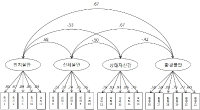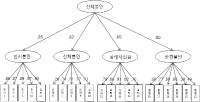PURPOSE This study examined the effects of focus of attention on beginning golfers’ competitive anxiety and motor performance. METHODS Forty-eight college students with no prior golf putting experience were selected as participants and randomly assigned to internal-focus, external-focus, holistic-focus, and control groups (12 participants each). All subjects performed 5-m golf putting in acquisition, noncompetitive, and competitive situations. RESULTS In competitive situations, the internal-focus, holistic-focus, and control groups showed golf putting accuracy and consistency similar to those in noncompetitive situations, whereas the external-focus group’s golf putting accuracy and consistency were significantly lower in competitive situations than in noncompetitive situations. In addition, the holistic-focus group showed significantly higher golf putting accuracy than the control group in both competitive and noncompetitive situations. CONCLUSIONS Holistic-focus can be used effectively as a strategy for beginners to learn motor skills and reproduce learned motor skills when state anxiety increases. However, external attention focus cannot be considered a strategy to induce effective beginners’ exercise performance when competitive state anxiety increases.
PURPOSE The purpose of this study was to verify the mediated effect between self-presentation, stress coping, and competitive state anxiety among domestic elite athletes and to identify the intermediate effects of stress coping in the relationship between self-presentation and competitive state anxiety. METHODS The study was conducted with 259 elite athletes. The relationship between self-presentation, stress coping and competitive state anxiety was verified using the SPSS and AMOS. RESULTS The results of this study were as follows. First, Self-presentation affected positively on stress coping. Second, Stress coping affected positively on competitive state anxiety. Third, Self-presentation affected positively on competitive state. Lastly, stress coping mediated significantly the relationship between self-presentation and competitive state anxiety. CONCLUSIONS The result of this study shows that the competitive anxiety of elite athletes depends on the meaning of self-presentation, and the stress coping is deeply related to competitive state anxiety. In conclusion, it was determined that it provided basic data to understand the competitive state anxiety of players in various ways.

The purpose of this study was to develop and validity Competitive State Anxiety Scale for Taekwondo Form athlete(CSATF). The participants were composed of the 48 Taekwondo Form athlete to explore sub-factors of Competitive State Anxiety for Taekwondo Form athlete. The data were collected by an open-ended questionnaire and interview. The participants were composed of 257 national Taekwondo Form athlete to develop Competitive State Anxiety Scale for Taekwondo Form athlete. This 157 athlete data were used for items analysis, reliability analysis and exploratory factor analysis. And 100 athlete data were utilized for confirmatory analysis. Also convergent validity, discriminant validity, predictive validity latent mean analysis of CSATF were performed The results of this study were as follows. Firstly, the results revealed that the four general dimensions were identified such as cognitive anxiety, somatic anxiety, state of confidence, environmental anxiety. Secondly, CSATF comprised cognitive anxiety(5 item), somatic anxiety(5 item), state of confidence(5 item) and environmental anxiety(6 item). Thirdly, convergent validity, discriminant validity and predictive validity, the multi-group analysis according to gender examined validity of CSATF.



